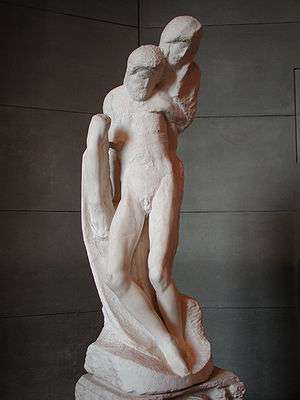Rondanini Pietà
| Rondanini Pietà | |
|---|---|
 | |
| Artist | Michelangelo |
| Year | 1564 |
| Type | Stone |
| Dimensions | 195 cm (77 in) |
| Location | Castello Sforzesco, Milan |
The Rondanini Pietà is a marble sculpture that Michelangelo worked on from 1552 until the last days of his life, in 1564. Several sources indicate that there were actually three versions, with this one being the last.[1][2] The name Rondanini refers to the fact that the sculpture stood for centuries in the courtyard at the Palazzo Rondanini in Rome.[3] Certain sources point out that biographer Giorgio Vasari had referred to this Pietà in 1550, suggesting that the first version may already have been underway at that time.[4] The work is currently housed in the Museum of Rondanini Pietà[5] of Sforza Castle in Milan.
This final sculpture revisited the theme of the Virgin Mary mourning over the emaciated body of the dead Christ, which he had first explored in his Pietà of 1499. Like his late series of drawings of the Crucifixion and the sculpture of the Deposition of Christ intended for his own tomb, it was produced at a time when Michelangelo's sense of his own mortality was growing.[6] He had worked on the sculpture all day, just six days before his death.[7]
The Rondanini Pietà was begun before The Deposition of Christ was completed in 1555. In his dying days, Michelangelo hacked at the marble block until only the dismembered right arm of Christ survived from the sculpture as originally conceived. The elongated Virgin and Christ are a departure from the idealised figures that exemplified the sculptor's earlier style, and have been said to bear more of a resemblance to the attenuated figures of Gothic sculpture than those of the Renaissance.[8][9] Some also suggest that the elongated figures are reminiscent of the style used in Mannerism.[10][11]
It has also been suggested that the sculpture should not be considered unfinished, but a work in a continuous process of being made visible by the viewer as he or she moves around to see it from multiple angles.[12]
South African visual artist Marlene Dumas based her 2012 painting Homage to Michelangelo on the Rondanini Pietà.[13]
References
- ↑ Enrica Crispino (2001). Auguste Tosone, ed. Michelangelo. Ediz. Inglese. Translated by Silvia Silvestri. p. 117. ISBN 88-09-02274-2.
- ↑ The final period: Last Judgment, frescoes of the Pauline Chapel, last Pietàs. Princeton University Press. 1960. p. 154.
- ↑ The Pietà Rondanini Retrieved 4 July 2018.
- ↑ Archana Srinivasan. World Famous Artists. Sura Books. p. 18. ISBN 81-7478-522-1.
- ↑ "Museum of the Pietà Rondanini". Retrieved 4 July 2018.
- ↑ Emma Barker; Nick Webb; Kim Woods, eds. (1999). The Changing Status of the Artist. Yale University Press. p. 23. ISBN 0-300-07740-8.
- ↑ (11 September 2010), The Rondanini Pieta Retrieved 4 July 2018.
- ↑ Rondanini Pieta Retrieved 4 July 2018.
- ↑ "Rondanini Pietà, last Michelangelo's masterpiece". The Italo-Americano. 20 April 2015. Retrieved 5 July 2018.
- ↑ L. E. Semler (1998). The English Mannerist Poets and the Visual Arts. Dickinson University Press. p. 247. ISBN 0-8386-3759-0.
- ↑ Cracking the ACT 2016. The Princeton Review/ACT. 2015. p. 264. ISBN 978-1-101-88198-9. ISSN 1059-101X.
- ↑ Ivana Vranic (2010). Visibility of Sculpted Matter and Form : Michelangelo’s Rondanini Pietà and the Ontological Nature of Sculpture. University of British Columbia Press. doi:10.14288/1.0071176.
- ↑ Marlene Dumas (2012). Written in the Stars. Milan: Sorte. pp. 39–43. ISBN 8836622852.